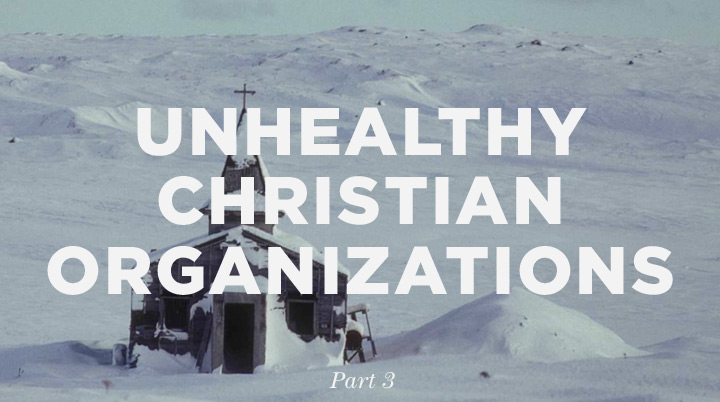Latest
-
Objections to the Christian Faith from the Unchurched and De-Churched
 Tue Dec 02, 2014
Tue Dec 02, 2014
by Resurgence -
Craig Groeschel: We Innovate for Jesus
 Tue Oct 14, 2014
Tue Oct 14, 2014
by Resurgence -
Mark Driscoll: Revelation
 Tue Oct 07, 2014
Tue Oct 07, 2014
by Resurgence -
RESURGENCE LEADERSHIP #034: JOHN PIPER, WHY I TRUST THE SCRIPTURES, PART 2
 Tue Sep 30, 2014
Tue Sep 30, 2014
by Resurgence -
Resurgence Leadership #033: John Piper, Why I Trust the Scriptures, Part 1
 Tue Sep 23, 2014
Tue Sep 23, 2014
by Resurgence

Archives
Considering (and surviving) unhealthy Christian organizations, Part 3

Previously, Ed wrote about six signs you may be working in an unhealthy Christian organization and how to discern from God when he might want you to leave or stay. Today, in the third and final post, he looks at how an organization moves from unhealthy to healthy.
An example of health in Phoenix
With this series of posts, I’ve had people from more than one organization ask if I was talking about them. To quote Rick Warren, no, “It’s not about you.” It is about a pattern that is both real and widespread. Some organizations really are unhealthier than others, and unfortunately I’ve seen it, as you probably have as well.
It’s interesting, however, to see “behind the curtain” of both healthy and unhealthy churches, organizations, and denominations. For example, while I was in Phoenix with the Foursquare church a few weeks ago, I was struck by their health and sense of family. Even as they disagreed, the focus was family and graciousness in their disagreement. People were allowed to ask questions, leadership was transparent, and trust was present. Having consulted with the Foursquare for five years now under two presidents (Jack Hayford and now Glenn Burris), I can tell you they have made great strides to get there—it takes effort to move to good health. It is not an easy process, and my Foursquare brothers and sisters would attest to that.
5 steps for an unhealthy organization to take
So, how does an organization move from unhealthy to healthy? Well, it is not simply something we can “will” into existence. Instead, it is a process.
1. The organization has to admit it has a problem
I know it’s cliché, but the first step toward health truly is admitting that you have a problem. Most unhealthy organizations act like they don’t want to know the truth and do everything to avoid realizing it. I once suggested an employee survey in such a place, and the response was quite telling: “We can’t do that because it will give everyone an opportunity to complain.” Indeed it might, and, I said, maybe you should listen. All organizations are made up of sinful, fallen people. There has to be enough freedom for those individuals, especially those in leadership, to be able to say “We are off track. We repent. God help us.”
2. The organization has to admit that sometimes unhealthy cultures come from unhealthy leaders
This is easily observed in the change that takes place with rising leaders as they come into closer proximity to existing leadership. Who are they becoming? With increased proximity, do you see the development of maturity, discernment, and the ability to address problems within the organization? Or do you see individuals jockeying for position, power, and limited privileges? One of the best things any leader can do is to lead through his or her own failings—and to admit them. To say things like, “I lose my temper sometimes, and I am sorry.” One of the best things a developing leader can do is to ask yourself as you grow closer to an organization’s leader, is your respect of that leader growing or diminishing? Are you being challenged to a higher level of character and integrity or being asked to lower it?
3. Those who are empowered by the bad leadership culture will need to work hard to resist it
This may be the most difficult step, because these are typically the same individuals who have thrived on the dysfunction and hardly want it to be seen. I recall one leader who would sandbag every attempt at internal analysis because he knew what it would find. He knew the organization was unhealthy and had managed to manipulate it for his personal gain.
Let me add that the pressure and culture found in unhealthy organizations also have some impact on those who benefit from them. While moral failings, scandals, and burnout are not unique to unhealthy organizations, they do seem to occur at a higher rate in those that are unhealthy. It should be no surprise when Christians fail morally when they have spent years ignoring the promptings of the Holy Spirit and the counsel of brothers and sisters in Christ in how to conduct themselves in the likeness of Christ.
4. The organization has to be willing to listen to its constructive critics
If no one can say to the leader, “There are issues,” well, then, there are issues. Big issues. Healthy organizations do not listen to every cynic (and there are many), but they do listen to discerning critics. For example, I have tried to surround myself with people who speak into my life and remind me that I am not a big deal and that I still have many areas in which to grow. These cannot all be people I have hired—though I will tell you, those I have hired seem to hold nothing back. Some work with me here at LifeWay, others are in the local church, and others are scattered across the country and the world.
5. The organization has to be willing to change
If the organization has been unhealthy, it’s likely that everyone knows it (except those who profit by its lack of health). Leaders must be willing to ask hard questions. Unfortunately, hard questions usually come with even harder answers. Willingness to change is sometimes the hardest part, but it’s also the most important and most rewarding.
There’s hope, help, and freedom
I sincerely hope that some organizations and churches will change for the better—both for their benefit and that of the kingdom. Perhaps in some small way this blog series will help. But, the reality is that most will not, and that’s why my last post encouraged you to get out if you find yourself in this situation.
Yet, there is hope. Like the characters in The Matrix, people increasingly come to realize they are not living in the real world and can unplug. When I did— and realized that the petty controversies and constant arguing were not the real world—I found a great deal of freedom in engaging real-world ministry without being pulled into organizational dysfunction.
This post originally appeared on Ed’s blog